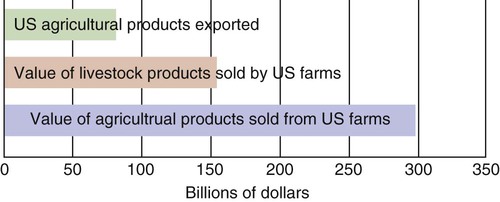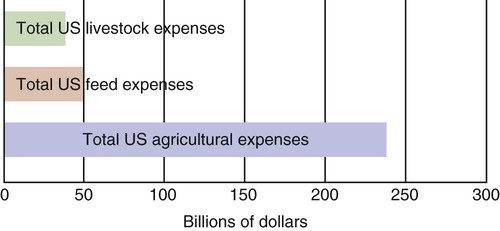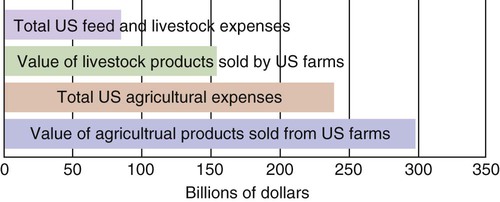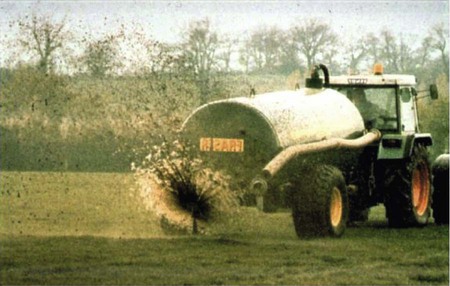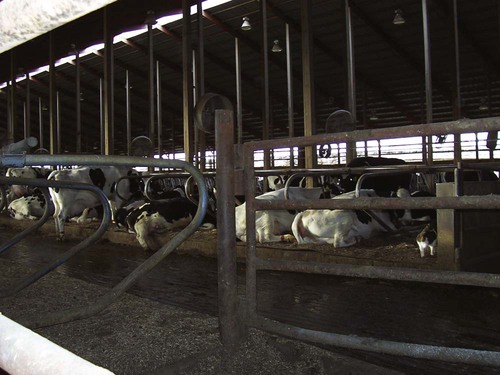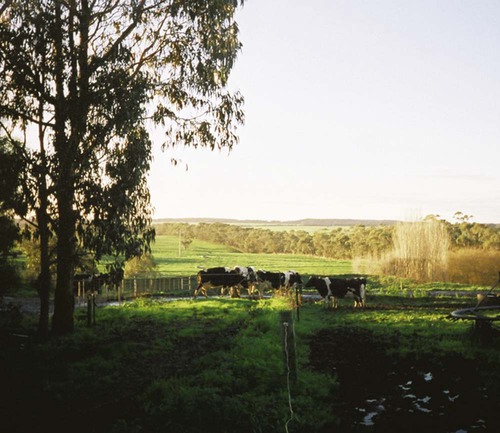After reading this chapter, you will be able to • List and explain the functions of livestock • Describe the economic importance of livestock • Describe the size and scope of the large animal industry • Describe the normal cycle that exists within the dairy industry • Describe the structure within the meat industry Agriculture is one of the oldest sciences, and one of the most important. Without a firm understanding of agriculture, all humans would struggle to find enough food, shelter, and clothing to survive. The main reason for maintaining our animal agricultural populations is to provide a nutritious and desirable form of food for human consumption. Only about 11% of the world’s land area is suitable for production of foods that can be directly consumed by humans. About 75% of energy intake consumed by ruminants and 30% from nonruminants is from waste materials that cannot be consumed directly by the human population. With world food production already inadequately able to provide balanced diets for people of the world, it is important that we continue to utilize livestock (Fig. 1-1). Supplies of protein are particularly scarce and costly for the populations of most developing countries. Malnutrition is the world’s number one health problem. The Economic and Social Council of the United Nations indicates that in 2009 there were an estimated 1.02 billion malnourished people in the world. An estimated 36 million people starve to death annually (www.un.org/ecosoc/). As global population continues to rise, the problem of inadequate food supplies will only continue to grow as well. For example, in terms of the global population crisis, in the time it takes you to read this sentence, 24 people will be added to the earth’s population; within an hour, the number will reach 12,000; by the day’s end, the number will be 288,000; and in 48 hours the human population growth will be enough to fill a city the size of San Francisco. Livestock producers also create income for the United States and stimulate the economy with the purchase of goods to raise livestock. According to the USDA 2007 agriculture census, producers spent $241 billion on production expenses in 2007, an increase of 39% since 2002. Of those production expenses, $49.1 billion was spent on feed, and $38 billion was spent on the purchase or lease of livestock. Jobs created from agriculture should not be overlooked when evaluating the importance of agriculture to our economy. Approximately one in every six jobs in private employment is related to agriculture. These statistics alone are the reason some economists believe that agriculture is the foundation of our economy (Figs. 1-2 to 1-4). By-products are any product produced by animals other than meat. These products contribute significantly to U.S. society. Examples of by-products include organs, fat, bones, and various glands. Examples of products made with by-products include candy, house insulation, gum, sandpaper, wallpaper, ice cream, fertilizers, canned meats, buttons, perfumes, glue, camera film, lanolin, gelatin desserts, marshmallows, dice, piano keys, toothbrushes, cosmetics, rug padding, waxes, soap lubricants, printing ink, candles, and upholstering materials for furniture. By-products are also used as feeds for other animals. Another major use of by-products includes medications, such as insulin, cortisone, epinephrine, thrombin, rennet, heparin, and corticotrophin. Not only do livestock contribute to medications, but they also supply a research model for scientists to study human and animal health (Fig. 1-5). Livestock are also doing their part to “go green.” Sixty-four percent of the U.S. land mass is used for the production of livestock: 36% for grazing and 28% for production of hay and other forage crops and grain. Livestock help conserve soil and soil fertility in the land on which these livestock feeds are grown. Livestock manure is applied to these areas to replenish nutrients in the soil used by plants for growth (Fig. 1-6). Organic agriculture is becoming a huge part of U.S. agricultural production, and livestock help play a role in conservation of our natural resources. Recreation is another benefit that can be attributed to the use of livestock in the United States. There are an estimated 6.9 million horses in the United States, and their owners annually spend an estimated $8.5 billion for feed and tack. This fact not only contributes to their economic importance but also signifies the importance of horses as a recreational hobby. More people attend horse races annually than see minor or major league baseball games or attend automobile races (Fig. 1-7). Horses are not the only animals used as a form of recreation. If you have ever visited a county or state fair, you have seen people enjoying the exhibition of livestock as well. Table 1-1 lists the 10 leading product production states for several livestock categories. TABLE 1-1 Leading States in Livestock and Livestock Production Commodity Cash Receipts *U.S. Department of Agriculture data for 2005. From www.ers.usda.gov for 2008. The most common type of dairy housing used into today’s industry is the free stall barn. Freestyle barns are loose housing systems (Fig. 1-8). The cows are able to move anywhere they wish throughout the pen (Fig. 1-9). These systems typically have resting areas for the cows to lie down. Advantages to free stall barns include cleaner environments, less bedding expense, ease of parlor use, fewer space requirements, fewer teat and udder injuries, and ease of use. Some dairy cattle are housed in dry lots or pastures and are brought inside only for milking in the parlor (Fig. 1-10).
The Importance of Livestock
The Importance of Livestock for the World
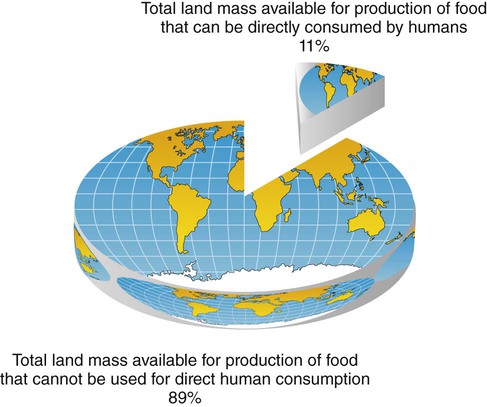
The Importance of Livestock in the United States
U.S. Livestock Trends
Rank
Leading States in Cash Receipts from Livestock
Beef Cattle and Calves
Swine
Dairy Products
Sheep and Lambs*
Wool*
1
Texas
Nebraska
Iowa
California
Texas
Texas
2
California
Texas
North Carolina
Wisconsin
California
Wyoming
3
Iowa
Kansas
Minnesota
New York
Wyoming
California
4
Nebraska
Colorado
Illinois
Pennsylvania
South Dakota
Colorado
5
Kansas
Iowa
Indiana
Idaho
Colorado
South Dakota
6
North Carolina
Oklahoma
Missouri
Minnesota
Montana
Montana
7
Wisconsin
California
Nebraska
Texas
Idaho
Utah
8
Minnesota
South Dakota
Oklahoma
Michigan
Utah
Idaho
9
Georgia
Missouri
Ohio
New Mexico
Iowa
Iowa
10
Arkansas
Idaho
Kansas
Ohio
Oregon
Oregon
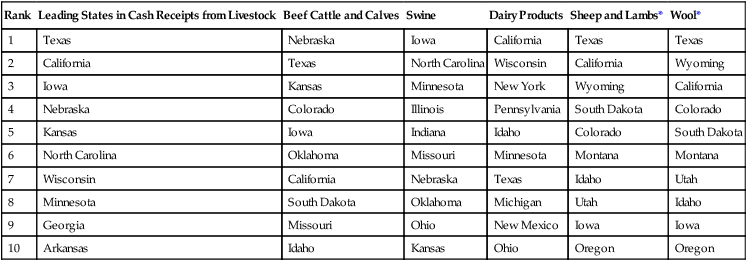
The Dairy Industry
Dairy Housing and Equipment
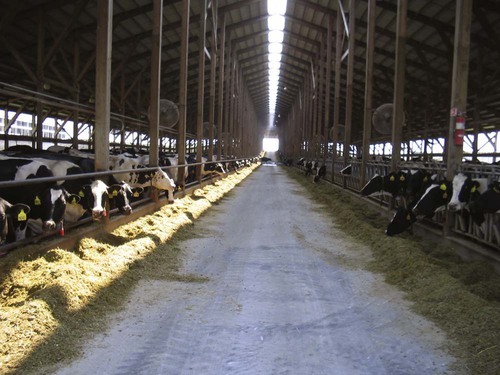
![]()
Stay updated, free articles. Join our Telegram channel

Full access? Get Clinical Tree


The Importance of Livestock

